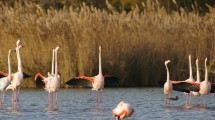Abstract.
Individual display rates and attractiveness of 17 radio-tagged, free-living great bustard males in north-western Spain were studied in relation to the degree of development of secondary sex traits, body condition, and age. Variance in display rate was significantly explained by body condition and length of moustache feathers, and neck development and display rate significantly accounted for the variance in male attractiveness. Age did not present any clear association with display rate or attractiveness, and it was significantly correlated only with neck development. These results suggest a total viability scenario of female mate choice in which the advertisement of global fitness is based on condition-dependent phenotypic and behavioural traits.
Similar content being viewed by others
Author information
Authors and Affiliations
Additional information
Electronic Publication
About this article
Cite this article
Morales, M.B., Alonso, J., Martín, C. et al. Male sexual display and attractiveness in the great bustard Otis tarda: the role of body condition. J Ethol 21, 51–56 (2003). https://doi.org/10.1007/s10164-002-0076-5
Received:
Accepted:
Issue Date:
DOI: https://doi.org/10.1007/s10164-002-0076-5




